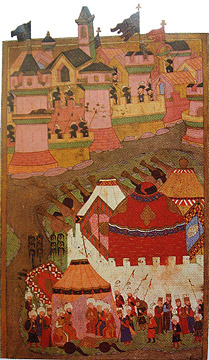Image Resource Bank
Image Gallery |  4 of 15
4 of 15 
First Ottoman Siege of Vienna (1529) (Siege of Vienna by Ottoman Forces)
In the early 1500s CE the Ottoman Empire included predominantly Muslim Egypt, Palestine, Syria, and Mesopotamia as well as predominantly Christian southeastern Europe, lands that now belong to Greece, Serbia, Bulgaria, and Hungary. On their eastern frontiers, the Sunni Ottoman rulers faced off against the Shi’i shahs of Safavid Persia, and on their western frontiers against the Catholic Habsburg rulers of Austria and the Holy Roman Empire.
Ottoman expansion into southeastern Europe reached its maximum extent just as the wars of religion were breaking out in western Europe. The struggle between the Habsburgs and the Ottomans took place deep within Christian Europe. It was and is sometimes portrayed as a contest between East and West, between Christendom and Islam, but at a time when Christendom was about to go to war with itself, when Persian shahs were sending emissaries to European kings and Ottoman sultans were sending support to Dutch Protestants, the real identity of the combatants was never so simple.
In 1529, the Ottoman Suleiman the Magnificent (1520-1566 CE) laid siege to Vienna, the eastern stronghold of the Habsburg Empire. This Ottoman illustration depicts the beginning of the siege, when massed Ottoman cannon bombarded the walls of Vienna without success. Suleiman and his richly dressed war council discuss the situation in a tent outside their fortified camp. The defenders, in fine black armor, under the black and gold standards of the Habsburgs, are apparently unaffected. The combatants are portrayed in flattering detail, accurate to the time, without any metaphorical allusions to past conflicts, and without any suggestion of brutality. Only the heavy castle-like fortifications are unrealistic versions of earthworks that defended the city.
Suleiman failed to capture Vienna. After another 150 years of competition, exchange, and conflict, culminating in another battle of Vienna in 1683, European powers began to push the Ottomans out of southeastern Europe. The knowledge of languages and lifeways gained during this intimate, painful embrace and struggle helped set the stage for European exploration of the Middle East in the eighteenth and nineteenth centuries.
Name: First Ottoman Siege of Vienna (1529) (Siege of Vienna by Ottoman Forces)
Material: Unknown
Size: Unknown
Date: 16th century CE
Place of Origin: Istanbul, Hachette, Collection “Voir”
Location: Unknown
Source and Registration#: Wikimedia Commons. Link to resource![]() (accessed August 17, 2009).
(accessed August 17, 2009).

 Matthew W. Stolper
Matthew W. Stolper
Professor of Assyriology and the John A. Wilson Professor of Oriental Studies




